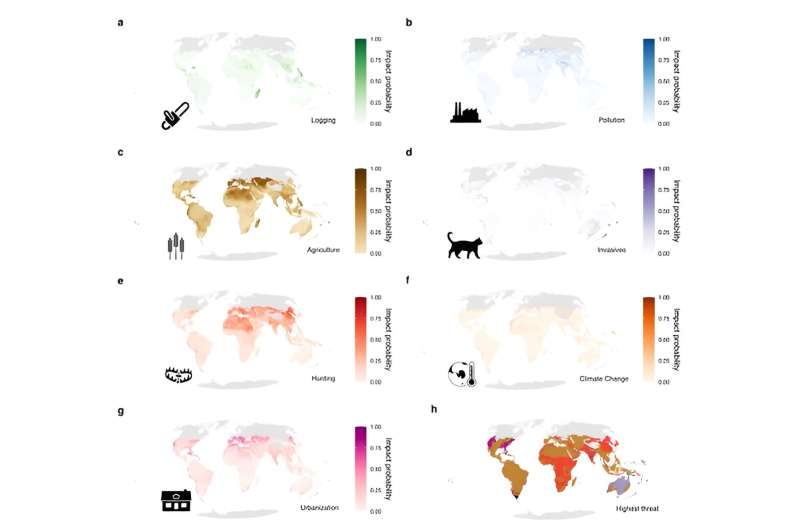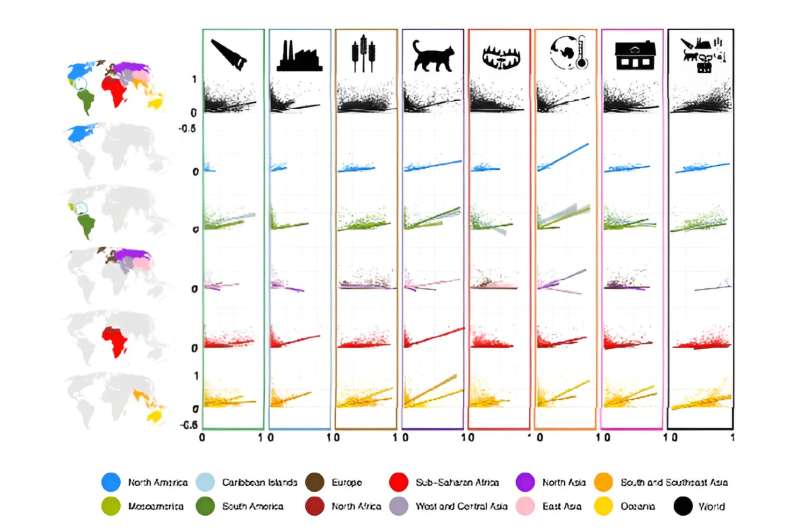September 16, 2023 feature
This article has been reviewed according to Science X's editorial process and policies. Editors have highlighted the following attributes while ensuring the content's credibility:
fact-checked
preprint
trusted source
proofread
Researchers use the power of comparative mapping to reveal specific global and regional threats to reptiles

According to the International Union for Conservation of Nature (IUCN), 21% of reptile species worldwide were threatened with extinction as of 2022. However, until recently there have been few details of the kinds of threats affecting distinct species in specific geographical areas, and as a result, important reptile conservation opportunities may have been missed.
A team of researchers from Denmark, Mozambique, Spain, Sweden, and the U.K. aims to provide more precision in this area. The team has calculated, at regional levels throughout the world, the probability that specific biodiversity threats could affect threatened species. Their work, titled "The threats to reptiles at global and regional scales," is published on the bioRxiv preprint server.
Reptiles can serve as bioindicators, giving clues to the overall health of ecosystems through symptoms or responses that can be easily measured.
According to the IUCN's 2022 data, there are 10,196 reptile species in the world, and at least 1,829 of them are listed as threatened. But as the study points out, the list of threatened species by itself is not enough to support effective conservation efforts; we need to know what and where specific threats are, and how likely they are to affect a given species.
From the IUCN Red List of threatened species, the researchers obtained range maps of reptile species, ultimately including ranges of 9,827 terrestrial reptiles in their study (48 species of sea snakes and six species of sea turtles were excluded).
Using information from the Intergovernmental Science-Policy Platform on Biodiversity and Ecosystem Services (IPBES) and taking into consideration IUCN threat classifications for land use, they focused on seven specific causes of biodiversity loss: alien species invasion, climate change, direct exploitation of natural resources, pollution; and specific to land use, the threats of agriculture, logging, and urbanization.
Using the distribution ranges of the species, they then created 50 km x 50 km grid layers for each of the seven threats (excluding cells with 10 or fewer species) and determined the probability of encountering threatened species in each cell, at the same time accounting statistically for areas of uncertainty.
For purposes of this analysis, "threatened" species included those classified by the IUCN as critically endangered, endangered, and vulnerable; and "non-threatened" species were those listed as near threatened or of least concern.
To show the intersection of the probabilities of individual threats affecting threatened species, the researchers created global and regional models, using 12 of the IUCN's 14 global regions. Due to a lack of data, these models did not include the Arctic and Antarctic regions.

Notably, the findings revealed that one or more of the seven threats affected 46% (4,551) of the terrestrial reptile species, with agriculture topping the lists of both the number of species affected (2,995; 30.5%) and its median likelihood of impact. Other threats showed varying median likelihoods of impact compared to the number of species affected.
Regionally, the highest median likelihood of impact was in Europe, with North Asia and the Caribbean Islands close behind. Global results showed diverse threats affecting different geographic areas. For example, the threat of agriculture was mostly seen in the Caribbean Islands, Central Asia, parts of Europe, and Madagascar, while hunting appeared as a leading concern in parts of China, India, and Sub-Saharan Africa.
Existing research has established that among vertebrates, terrestrial reptiles are especially vulnerable to biodiversity loss. The findings of this new study are significant because they are the first to map the likelihood of impact from specific threats, thus paving the way for effectively targeted conservation initiatives.
The team acknowledges several considerable study limitations, including the inability to perform high-resolution analysis, owing to uncertainty linked to IUCN's range maps; the inability to ascertain direct causation between a specific threat and a species receiving a "threatened" classification; and possible under-reporting, uneven sampling, and insufficient fieldwork supporting IUCN Red List threat assessments.
Nevertheless, the researchers state, "Our approach allowed us not just to detect where species are being impacted by human actions, but also to gauge how this impact potential relates to the risk of extinction," and they reiterate the crucial importance of understanding the relationship between the likelihood of a threat and its effects on a threatened species.
To that end, their work ends with a call for heightened local documentation of biodiversity, "addressing the gap in studies that comprehensively capture diversity threats."
More information: Harith Farooq et al, The threats to reptiles at global and regional scales, bioRxiv (2023). DOI: 10.1101/2023.09.08.556803
Journal information: bioRxiv
© 2023 Science X Network





















